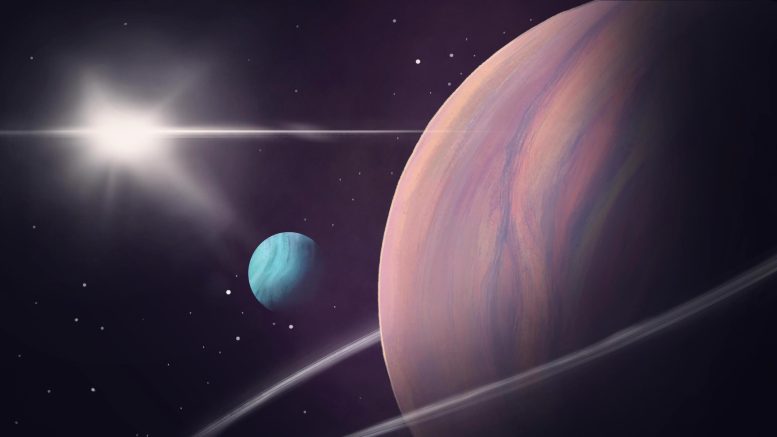
The discovery of a second exomoon candidate hints at the possibility that exomoons may be as common as exoplanets. Credit: Helena Valenzuela Widerström
Astronomers have identified a potential second exomoon orbiting a distant Jupiter-sized planet.
Led by David Kipping of Columbia University’s Cool Worlds Lab, this discovery suggests exomoons may be as prevalent as exoplanets. While difficult to confirm, these celestial bodies could provide insights into planetary formation and the potential for life in the universe.
Discovery of a Second Exomoon
Astronomers have reported a second, super-sized moon orbiting a Jupiter-sized planet beyond our solar system. If confirmed, the sighting could mean that exomoons are as common in the universe as exoplanets, and that big or small, such moons are a feature of planetary systems. But it could be a long wait. The first-ever sighting of an exomoon four years ago is still awaiting confirmation, and verification of this newest candidate could be as equally long and contentious.
The discovery, published in Nature Astronomy, was led by David Kipping and his Cool Worlds Lab at Columbia University, which reported the first exomoon candidate in 2018.
Challenges in Exomoon Detection
“Astronomers have found more than 10,000 exoplanet candidates so far, but exomoons are far more challenging,” said Kipping, who has spent the last decade hunting for exomoons. “They are terra incognita.”
The team spotted the giant exomoon candidate orbiting the planet Kepler 1708b, a world 5,500 light-years from Earth in the direction of the Cygnus and Lyra constellations. This new candidate is about a third smaller than the Neptune-sized moon that Kipping and his colleagues earlier found orbiting a similar Jupiter-sized planet, Kepler 1625b.
The Nature of Exomoons
Both supermoon candidates are likely made of gas that has piled up under the gravitational pull caused by their enormous size, said Kipping. If one astronomer’s hypothesis is correct, the moons may have even started life as planets, only to be pulled into the orbit of an even bigger planet like Kepler 1625b or 1708b.
Both moons are located far from their host star, where there’s less gravity to tug at planets and strip off their moons. In fact, the researchers sought out cold, giant gas planets on wide orbits in their search for exomoons precisely because the analog in our own solar system, Jupiter and Saturn, have more than a hundred moons between them.
If other moons are out there, they will likely be less monstrous, but also harder to spot, said Kipping. “The first detections in any survey will generally be the weirdos,” he said. “The big ones that are simply easiest to detect with our limited sensitivity.”
Significance and Verification of Exomoons
Exomoons fascinate astronomers for the same reasons that exoplanets do. They have the potential to reveal how and where life may have emerged in the universe. They are also curiosities in their own right, and astronomers want to know how these exomoons form, if they can sustain life, and what role, if any, they play in making their host planets habitable.
In the current study, the researchers looked at the sample of the coldest gas giant planets captured by NASA’s planet-hunting spacecraft, Kepler. After scanning 70 planets in depth, they found just one candidate — Kepler 1708b — with a moon-like signal. “It’s a stubborn signal,” said Kipping. “We threw the kitchen sink at this thing but it just won’t go away.”
Observations from other space telescopes, like Hubble, will be needed to verify the discovery, a process that could take years. Four years later, Kipping’s first exomoon discovery continues to be hotly debated. In a recent paper, he and his colleagues showed how one group of skeptics may have missed Kepler 1625b’s moon in their calculations. Meanwhile, Kipping and colleagues continue to investigate other lines of evidence.
Eric Agol, an astronomy professor at University of Washington, said he’s doubtful that this latest signal will turn out to be real. “It might just be a fluctuation in the data, either due to the star or instrumental noise,” he said.
Others sounded more optimistic. “This is science at its best,” said Michael Hippke, an independent astronomer in Germany. “We find an intriguing object, make a prediction, and either confirm the exomoon candidate or rule it out with future observations.”
“I am very excited to see a second exomoon candidate, although it is unfortunate that only two transits have been observed,” he added. “More data would be very cool.”
Spotting a moon or even a planet hundreds to thousands of light-years from Earth is anything but straightforward. Moons and planets can only be observed indirectly as they pass in front of their host stars, causing the star’s light to intermittently dim. Catching one of these fleeting transit signals with a telescope is tricky, and so is interpreting the light-curve data. Moons are even harder to detect because they’re smaller and block less light.
But the search is worth it, said Kipping, as he recalled how the existence of exoplanets was greeted with the same skepticism as exomoons are today. “Those planets are alien compared to our home system,” he said. “But they have revolutionized our understanding of how planetary systems form.”
Reference: “An Exomoon Survey of 70 Cool, Giant Exoplanets and the New Candidate Kepler-1708b-i” by David Kipping, Steve Bryson, Chris Burke, Jessie Christiansen, Kevin Hardegree-Ullman, Billy Quarles, Brad Hansen, Judit Szulágyi and Alex Teachey, 13 January 2022, Nature Astronomy.
DOI: 10.1038/s41550-021-01539-1
Other authors are: Steve Bryson, NASA Ames Research Center; Chris Burke, MIT; Jessie Christiansen and Kevin Hardegree-Ullman, Caltech; Billy Quarles, Valdosta State University; Brad Hansen, University of California, Los Angeles; Judit Szulagyi, ETH Zurich; and Alex Teachey, Columbia.









Proud to be a monetary supporter of Dr. Kipping and his team! Love watching their “Cool Worlds” videos. Wonderfully informative, made for us ‘lay persons,’ we’ve got to watch their progress on exo-planets and were surprised when they announced their paper on exo-moons! Can’t wait for more discoveries!
very fascinating. I can’t wait for the day where we are able to colonize other worlds
what a waste of time , it would take 99 million year to reach it